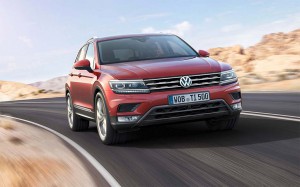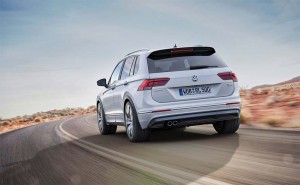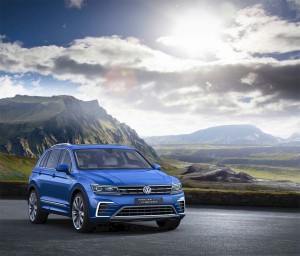When it comes to Volkswagen’s line-up, there’s a hole biggest enough to drive an SUV through. Make that several of them. The German maker has admittedly missed out on the explosive growth of the global utility vehicle market, and it’s planning to correct that with the upcoming launch of new models like the CrossBlue.
But VW also intends to update its existing SUV models, starting with the introduction of a new Tiguan at the Frankfurt Motor Show this week.
Migrating to VW’s new global architecture, the redesigned Tiguan is longer, lower, wider and, the German maker claims, boasts “sportier proportions.” It also will offered in a number of new versions, including both off-road and performance-oriented R-Line packages. Meanwhile, the Tiguan GTE concept hints of a plug-in hybrid version to come.
There’s a reason for VW’s push to update the Tiguan. The maker estimates the segment it competes in will surge by 9% between now and 2018, to about 8.93 million vehicles in annual sales. Originally launched in 2007, Tiguan has been a mid-pack player but the German maker is intent on putting it in the segment lead, something that could be critical if VW expects to become the global automotive sales leader, as planned, by 2018.
(VW bringing Clubsport, the fastest GTI ever, to Frankfurt. Click Here to check it out.)
The exterior styling of the new Tiguan is more evolutionary than revolutionary, though the revised dimensions give it a more planted, aggressive look. Credit goes to the switch to the new MQB architecture that debuted under the new Volkswagen Golf and will soon be shared with the vast majority of VW-brand products.
The European version, which will reach showrooms in April 2016, gets a notable increase in usable interior space. Passengers aren’t the only ones who will benefit, the new Tiguan adding 1.8 cubic feet of cargo space, for a total of 18.4 cf. That jumps to 58.5 cf with the rear seat down, or 5.1 more than with the old ute.
Americans buyers will get an even more roomy version of the new Tiguan, Volkswagen promises, but they’ll have to wait until next autumn for it to reach U.S. showrooms.
(Bentley previews the Bentayga SUV ahead of Frankfurt debut. Click Here for a closer look.)
Depending on market, the new VW Tiguan will be offered with a wide range of gas and diesel powertrains, from 123-to 238-hp. In European trim, VW promises up to a 24% bump in fuel efficiency. The maker’s 4Motion system has been updated, and the new ute will be able to tow up to 5,512 pounds.
While it isn’t yet confirming production plans, VW is clearly looking at the potential for a plug-in version, dubbed the Tiguan GTE. That version would yield about 123 mpg using the European test cycle – which usually generates results at least 25% higher than what the American EPA numbers would come in at. Meanwhile, VW claims all-electric driving range would be substantially boosted by the Tiguan GTE concept’s solar roof.
Moving in the other direction, VW will offer an R-Line package. Though it doesn’t offer a performance boost, the package is designed to give the new Tiguan an even more sporty appearance. Buyers will be able to opt for an R-Line makeover, inside and out, or just the exterior package.
Other features of the new VW Tiguan include an optional, 3-zone Pure Air Climatronic system with a special filter to keep pollutants out of the cabin. Depending upon choice, customers will be offered either a 5-inch or 8-inch touchscreen infotainment system. Apple CarPlay and Google Android Auto also will be available through the App Connect system.
(What is this mystery car from Nissan? Click Here to find out.)





Other than North America I am unaware of other countries where SUVs are even remotely as popular as here. Profilers in Japan and the Middle-East might buy their decked out gold plated SUVs but that volume is low compared to car sales. Not everyone owns an oil company and many don’t view SUVs as practical even with lower fuel prices of $6/gal. in some countries.